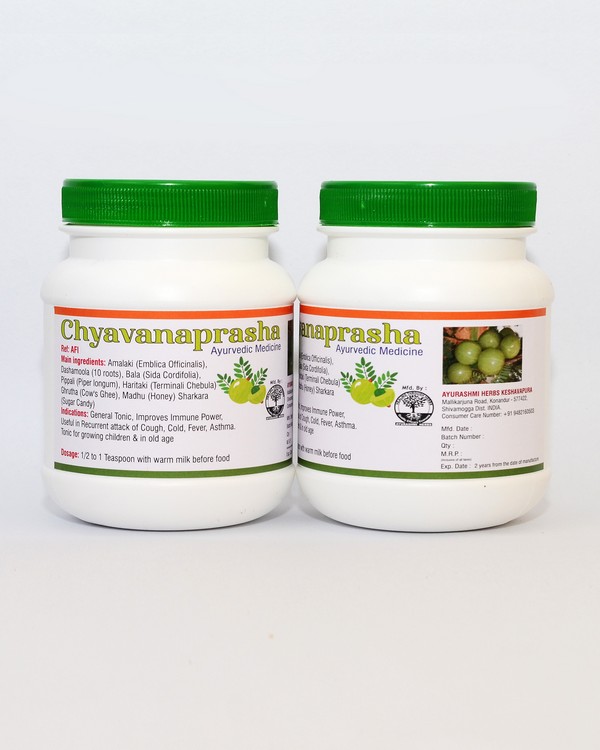1. Introduction
Chyawanprash (CP) (also known as chyavanaprasha, chyavanaprash, chyavanaprasam, and chyawanaprash) comprises two lexes, “Chyawan” and “Prasha”. The word Chyawan is the name of a sage, and also symbolizes ‘degenerative change’. Prasha denotes a drug or foodstuff that is suitable for consumption. Indeed, CP is a comprehensive ‘metabolic’ tonic; it contains a variety of herbs and is used to promote health and prevent diseases. Chyawanprash is an ancient Indian formulation (a polyherbal jam), prepared according to a traditional Ayurvedic recipe, enriched with several herbs, herbal extracts, and processed minerals. Regarded by many experts as an essential health supplement, CP has been around for centuries. Chyawanprash possesses multiple health benefits and has been widely used since ancient times as a health supplement and as a medicine for enhancing immunity and longevity. Chyawanprash has been a part of every Indian’s life from the day it was introduced, irrespective of sociocultural, political, and scientific factors. It was one of the most appreciated foods for its antiaging effects long before vitamins, minerals, and antioxidant supplements came into existence [1].
Rasayana, a branch of Ayurveda, includes a number of specialized approaches aimed at prolonging life, preventing aging and diseases, eliminating degenerative processes, and promoting excellent health. Of all the Rasayana formulations enumerated during the classical and medieval periods, CP undoubtedly stands out as the most important. This formulation has made major strides as an over-the-counter product since it entered the consumer market in the 1950s. It is highly appreciated for possessing multiple health benefits and addressing the preventive, promotive, and curative aspects of health.
Chyawanprash consists of Amla/Amalaki (Phyllanthus emblica/Indian gooseberry) pulp as a base, and this is considered to be the most effective Rasayana for sustaining homeostasis [2]. Chyawanprash that contains Amla has a mixed taste, combining sweet, sour, bitter, pungent, and astringent qualities [3]. On regular intake, it maintains physiological functions and rejuvenates the whole body system [4].
2. Origin
The atypical name of CP originates from the legend of Chyawan Rishi, who was a forest sage. Various ancient sacred treatises, such as the Mahabharata, the Puranas, etc., describe how the twin Ashwini Kumar brothers (the royal physicians to the Gods during the Vedic era) invented this polyherbal preparation to make the sage Chyawan Rishi younger and improve his vitality and strength. The formulation was prepared at his hermitage at Dhosi Hill near the Narnaul area, in the state of Haryana, India; drawing its name from the ancient sage, the formula was called “Chyawanprash”. He followed strict practices to become enlightened, and this had made him weak, emaciated, and aged. To regain his youthfulness, vitality, and strength, he used CP [5,6,7,8]. The foremost historically recorded recipe for CP is reported in the Charaka Samhita, the ancient Ayurvedic classic, where it is appreciated as being superior to all other herbal rejuvenative tonics [9].
3. Composition
Chyawanprash is a potent antioxidant paste, prepared through the synergistic blending of around 50 herbs and spices. Chyawanprash falls, by virtue of its consistency and form of dosage, under the category of Awaleha (electuaries/herbal jams), a group of Ayurvedic formulations [10]. Typically, CP includes four classes of herbal drugs: The Dashmula class (ten roots); the Chaturjata class (four aromatic plants); Ashtavarga (threatened medicinal herbs from the Northwest Himalayas, which are not commercially available in the modern era) [11]; and a general class (materials not belonging to the former classes). The Chyawanprash formula is described in the ancient Ayurvedic texts, namely, Ashtanga Hridayam, Charaka Samhita, Sangandhara Samhita, which are dedicated to clinical management. The dominant ingredient is Amla, a citrus fruit that is a highly renowned and potent botanical in Ayurveda.






Reviews
There are no reviews yet.